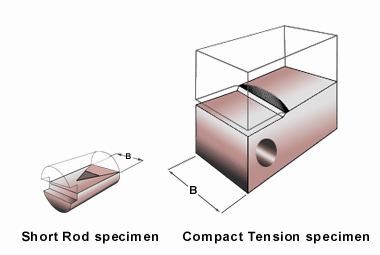
No Fatigue Pre-cracking
In the short rod test specimen, a natural, quasi-steady state crack is developed simply by applying an opening load to the two specimen halves. This means that fatigue pre-cracking is not required for the development of the crack. Eliminating fatigue pre-cracking results in substantially lower testing costs.
There are some very brittle materials (e.g. ceramics, tungsten carbides) which either cannot be pre-cracked or are very difficult to pre-crack. The short rod test method can be used to easily measure the plane-strain fracture toughness of these types of materials.
Natural Crack
In the short rod test method, a natural crack is developed, even in extremely brittle materials. Thus, the test method is based on plane-strain fracture toughness at a real crack rather than at an artificially machined slot where the fracture toughness may be sensitive to the radius or size of the machined notch.
Small Test Specimen Size
A valid plane-strain fracture toughness test requires a minimum specimen size to assure that the crack front is subject primarily to plane strain conditions. The minimum valid size for a short rod test specimen is one where the minimum "B" dimension is half the minimum "B" dimension for a compact tension (E 399) test specimen of the same material. This minimum short rod test specimen is only 3% of the volume of the equivalent compact tension test specimen. Not only does this smaller size reduce significantly the amount of material required to perform a test, but it allows fracture toughness tests on materials where limited section thickness is available for a test specimen. In addition, the small size allows local measurement of fracture toughness. This can be important in materials such as aluminum plate, where fracture toughness varies as a function of depth in the plate.
The relative sizes of a minimum size short rod test specimen and a minimum size compact tension test specimen are shown in the illustration below.

Eliminating the need for fatigue pre-cracking and using relatively small test specimens contribute to reducing the cost of plane-strain fracture toughness testing by a factor of two to four times.
Applicable to Brittle and Non-Brittle Materials
Because a natural crack is developed without fatigue pre-cracking in the short rod test, the test can be applied to brittle as well as more plastic materials.
Fracture Toughness as a Function of Crack Length
The crack that is developed in a short rod test is a quasi-steady state crack which grows in a stable manner over a finite crack length. Thus, plane-strain fracture toughness can be measured at several different crack lengths. This can be useful particularly in materials where fracture toughness varies through a material section.
Calculations Based on Peak Load Only
In materials where plasticity is known to be small and the materials do not exhibit high pop-in on crack initiation, a fracture toughness measurement can be made simply by recording the peak load during the test. This eliminates the need for instrumentation to measure specimen mouth opening, simplifying and reducing the cost of the test.
Indication of Plasticity or Residual Stress Effects
The load-displacement test record from a short rod test, if unloading-reloading cycles are performed during the test, can indicate whether there are plasticity or residual stress effects on the fracture toughness measurement.
TN 501 | TN 502 | TN 503 | TN 504 | TN 505 | TN 506